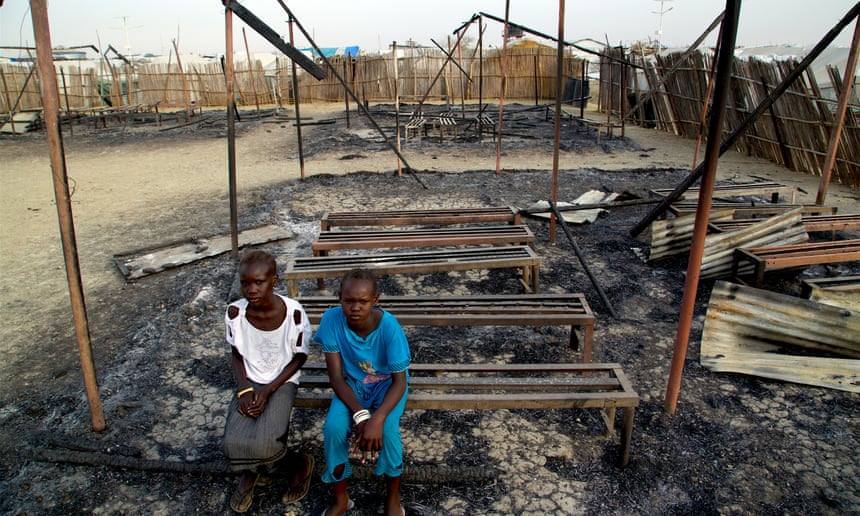
Girls sit amid the ruins of a primary school burned down in fighting at the Malakal protection of civilians site in South Sudan. Photograph: George/Unicef
South Sudan has been named as the toughest nation in the world for girls to receive an education, with nearly three-quarters failing to attend even primary school, according to an index published this week.
Central African Republic, where there is only one teacher for every 80 students, and Niger, where just 17% of women aged 15 to 24 are literate, followed South Sudan on the list compiled by the One campaign, which estimates that more than 130 million girls worldwide fail to attend school every single day of the year.
Nine of the top 10 most difficult nations for girls to be educated are in sub-Saharan Africa. Afghanistan, which has the highest level of gender disparity in primary school, is the only non-African country to make the list, ranking in fourth place. Chad is fifth, followed by Mali, Guinea, Burkina Faso, Liberia and Ethiopia.
Some countries – including Somalia and Syria – could not be included on the list as they had insufficient data about girls and education rates. Although many school-age boys in conflict zones, including the 10 countries listed, often fail to attend class, in some nations the gender gap is particularly striking. In Central African Republic, for example, nearly twice as many girls (38%) are out of school as boys (20%).
Research shows that girls who are not educated are more at risk of poverty, child marriage, violence and prone to diseases, including HIV and Aids.
Gayle Smith, president of the One campaign, said the failure to both educate and count girls in education is “a global crisis that perpetuates poverty”.
“Over 130 million girls are still out of school – that’s over 130 million potential engineers, entrepreneurs, teachers and politicians whose leadership the world is missing out on,” said Smith. “This is not just about getting more girls into school, it’s about the women they grow up to be: educated, empowered and employed.”
In most of the 10 countries, more than half of girls are married before their 18th birthday, according to the report, and one in four are, on average, child labourers. But even in countries that spend a significant portion of their budget on education – including Ethiopia and Niger – factors such as extreme poverty, child marriage, and cultural and economic barriers still prevent girls from gaining an education.
“The intention of the index is to start a conversation on this issue,” said Alice Jowett, One campaign’s education policy manager. “But we have to highlight that there are big data gaps, and we need to invest more in data in general. One of the things we suggest is that national governments appoint a ministerial lead for looking into why girls don’t finish school and how those nations can address some of those barriers.”
The One campaign and YouTube launched a joint #GirlsCount project on Wednesday to urge world leaders to prioritise girls’ education and mark the International Day of the Girl. More than 50 YouTube creators from around the world – with a combined outreach of more than 32 million viewers – have contributed a video to commemorate the 130 million girls who fail to attend school. Nobel peace laureate Malala Yousafzai actor Charlize Theron and YouTube vloggers TheSorryGirls have also contributed to the #GirlsCount campaign.
In February, activists will lobby world leaders to fund the Global Partnership for Education, an international fund that supports schooling in developing countries.
“In 2018 leaders have a chance to turn the corner on the girls education crisis – it starts with fully funding the Global Partnership for Education,” said Smith. “This is a global crisis and it needs an emergency response.”
[“Source-theguardian”]




